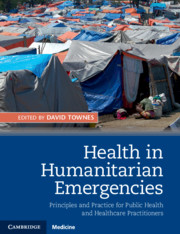 Health in Humanitarian Emergencies
Health in Humanitarian Emergencies Book contents
- Health in Humanitarian Emergencies
- Health in Humanitarian Emergencies
- Copyright page
- Dedication
- Contents
- Contributors
- Foreword
- Abbreviations
- Section 1 Humanitarian Emergencies
- Section II Public Health Principles
- Chapter 7 Needs Assessments
- Chapter 8 Surveys
- Chapter 9 Surveillance
- Chapter 10 Monitoring and Evaluation
- Chapter 11 Water, Sanitation, and Hygiene (WASH)
- Chapter 12 Nutrition
- Chapter 13 Food Security
- Chapter 14 Reproductive Health
- Chapter 15 Protection
- Chapter 16 Vaccine-Preventable Diseases
- Chapter 17 Camp Management
- Chapter 18 Shelter and Settlements
- Chapter 19 Logistics
- Chapter 20 Disaster Risk Reduction
- Section III Illness and Injury
- Index
- References
Chapter 11 - Water, Sanitation, and Hygiene (WASH)
from Section II - Public Health Principles
Published online by Cambridge University Press: 26 July 2018
- Health in Humanitarian Emergencies
- Health in Humanitarian Emergencies
- Copyright page
- Dedication
- Contents
- Contributors
- Foreword
- Abbreviations
- Section 1 Humanitarian Emergencies
- Section II Public Health Principles
- Chapter 7 Needs Assessments
- Chapter 8 Surveys
- Chapter 9 Surveillance
- Chapter 10 Monitoring and Evaluation
- Chapter 11 Water, Sanitation, and Hygiene (WASH)
- Chapter 12 Nutrition
- Chapter 13 Food Security
- Chapter 14 Reproductive Health
- Chapter 15 Protection
- Chapter 16 Vaccine-Preventable Diseases
- Chapter 17 Camp Management
- Chapter 18 Shelter and Settlements
- Chapter 19 Logistics
- Chapter 20 Disaster Risk Reduction
- Section III Illness and Injury
- Index
- References
- Type
- Chapter
- Information
- Health in Humanitarian EmergenciesPrinciples and Practice for Public Health and Healthcare Practitioners, pp. 136 - 160Publisher: Cambridge University PressPrint publication year: 2018


